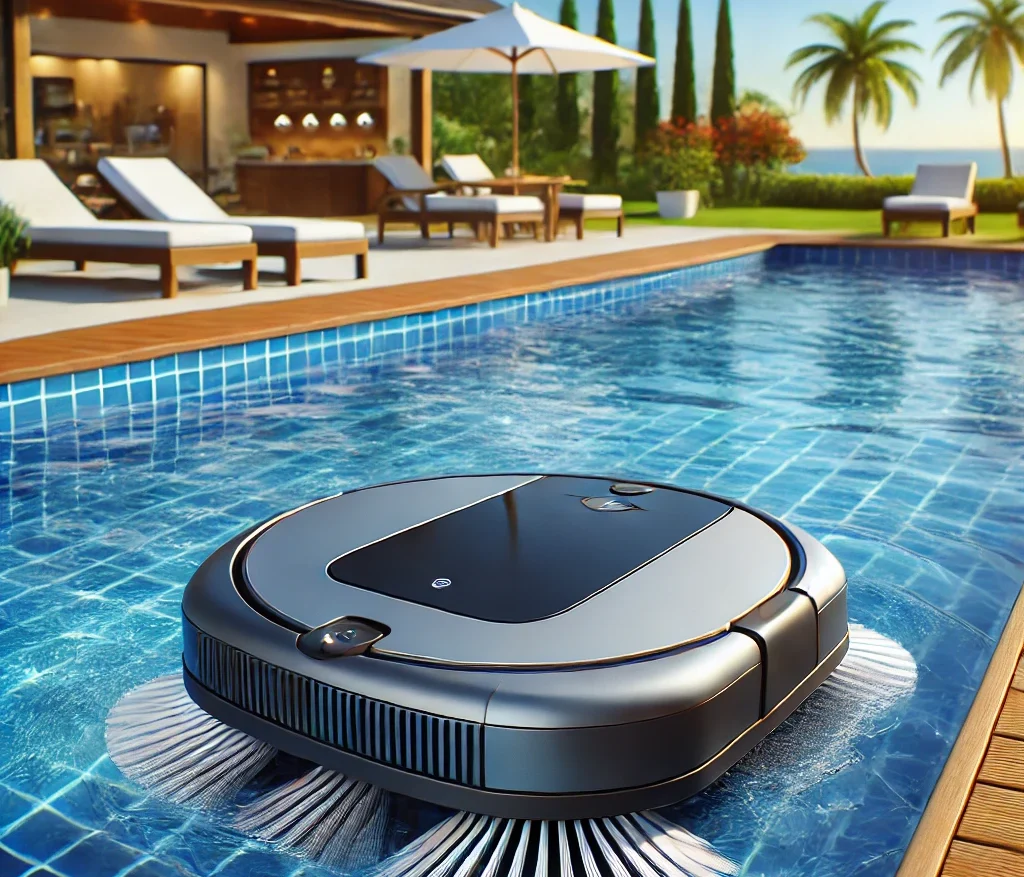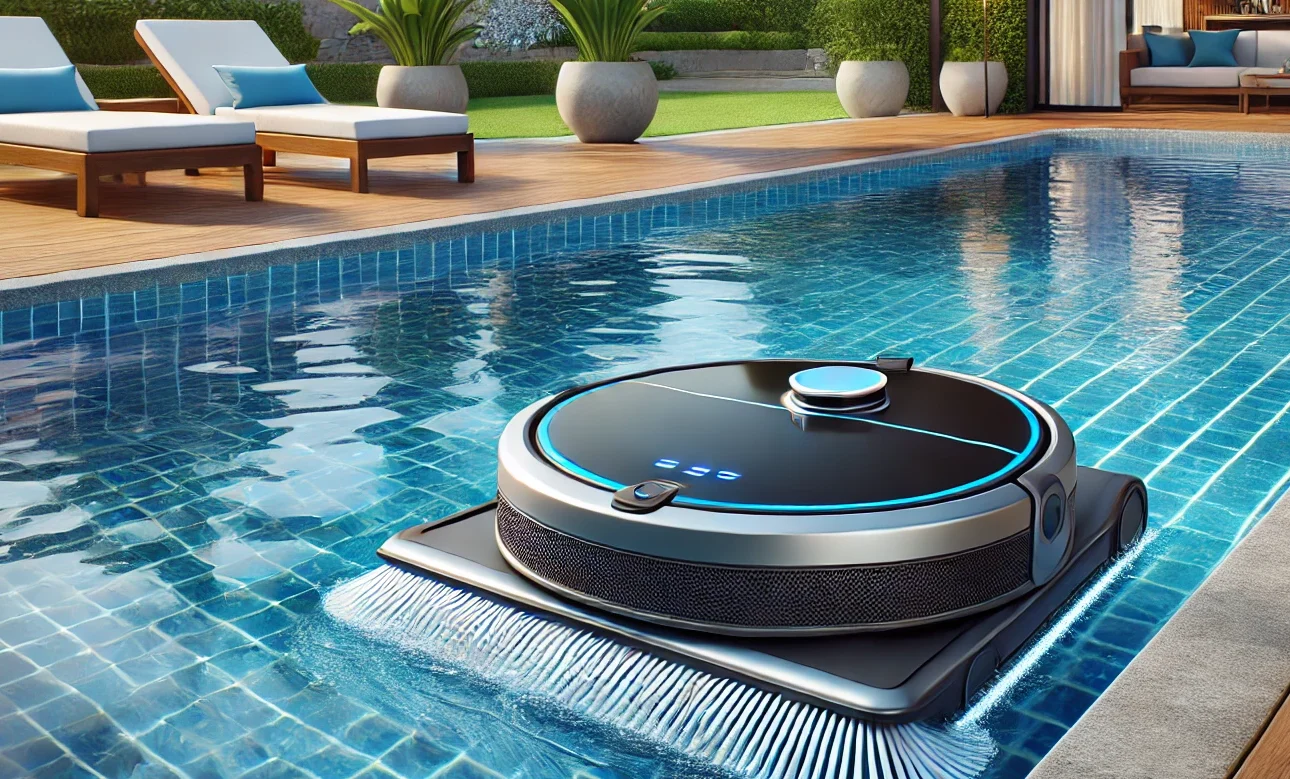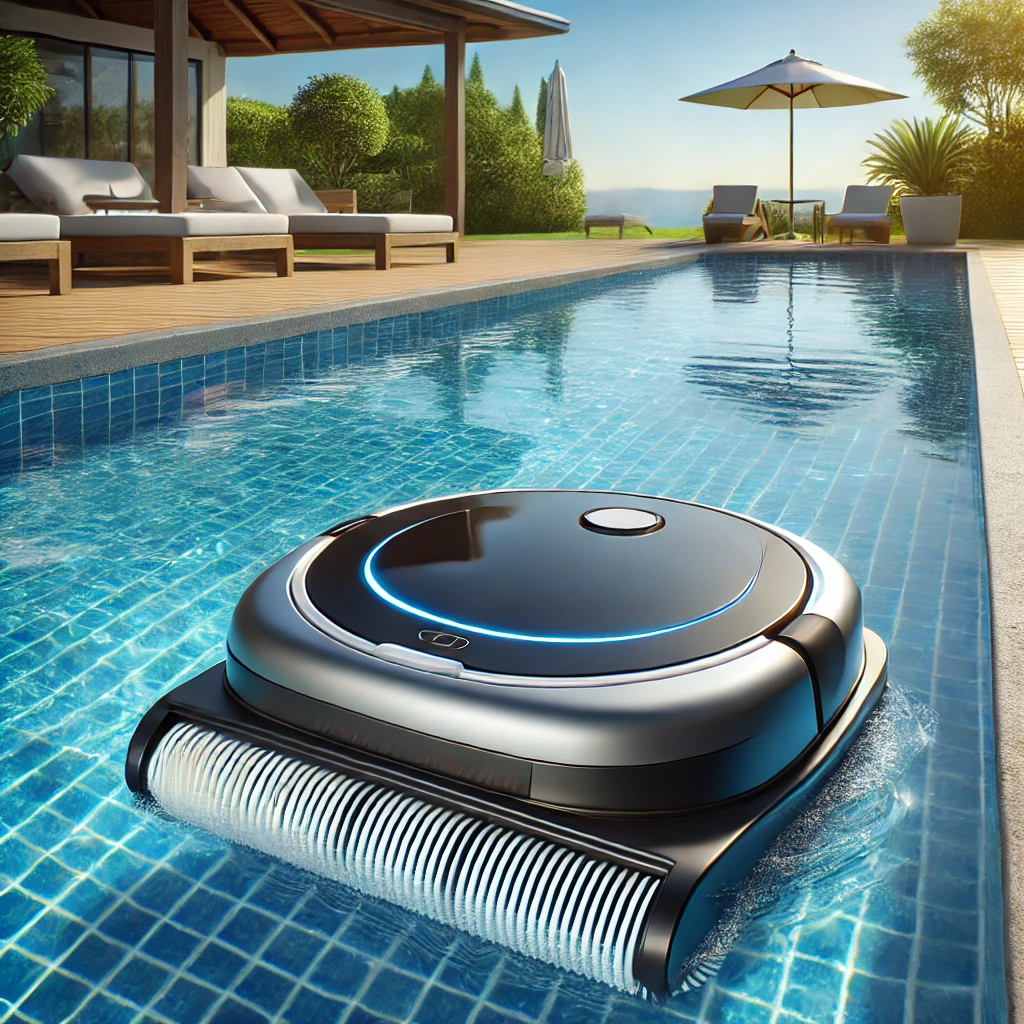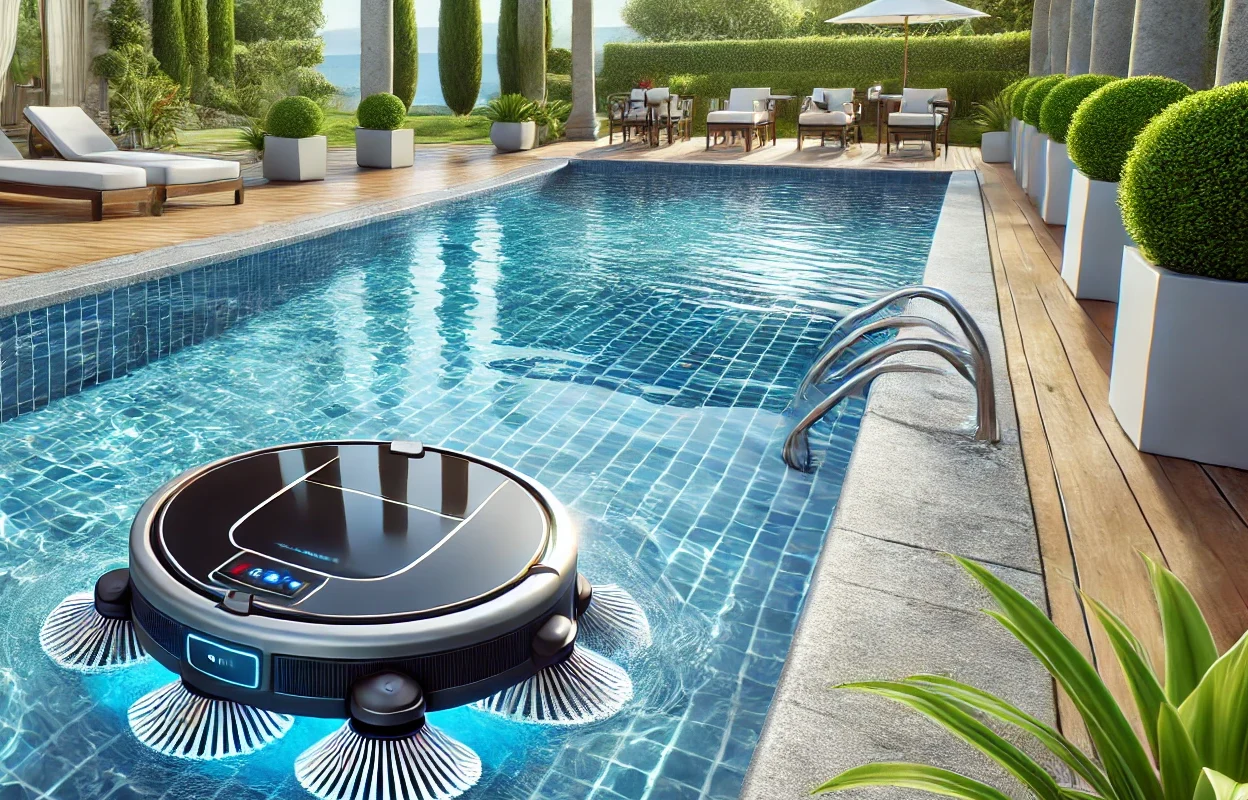Table of Contents
ToggleIntroduction to Robotic Pool Cleaners
What is a Robotic Pool Cleaner?
A robotic pool cleaner is an autonomous tool made to clean the pool with the least amount of human assistance. These cleaners operate independently of the pool’s filtration system, using built-in electric motors and advanced sensors to navigate the pool. Equipped with brushes, vacuum systems, and filtration units, robotic pool cleaners scrub the pool surfaces, vacuum debris, and filter out contaminants, leaving the pool water clean and clear. They are designed to work on different pool surfaces, including tiles, vinyl, and concrete, making them versatile and effective for various pool types.

History and Evolution
The concept of robotic pool cleaners dates back to the late 20th century, with the first commercial models appearing in the 1980s. These early models were relatively simple, relying on basic navigation systems and manual programming. However, as technology advanced, so did the capabilities of these cleaners. The introduction of microprocessors, sensors, and improved electric motors allowed for more efficient and intelligent cleaning patterns. Today, modern robotic pool cleaners are equipped with cutting-edge technology such as artificial intelligence, machine learning, and remote control capabilities, making them highly efficient and user-friendly. The evolution of these devices has significantly reduced the time and effort required for pool maintenance, transforming it from a labor-intensive task to a hassle-free experience.
Importance of Pool Maintenance
Proper pool maintenance is crucial for several reasons. Firstly, it ensures a safe and healthy swimming environment by removing harmful bacteria, algae, and debris that can accumulate in the water. Second, frequent cleaning and upkeep stop dirt and grime accumulation, which over time can harm the pool’s surfaces and filtration system. This not only extends the lifespan of the pool but also reduces the need for costly repairs and replacements. Furthermore, a well-maintained pool enhances the overall aesthetic appeal of the outdoor space, creating a welcoming and enjoyable environment for swimmers. Robotic pool cleaners play a vital role in achieving these maintenance goals, offering a convenient and efficient solution for pool owners.
How Robotic Pool Cleaners Work
Basic Mechanisms
At the core of a robotic pool cleaner’s operation are its basic mechanisms. These cleaners are powered by electric motors that drive both the movement and the cleaning functions. They typically move across the pool floor and climb walls using a combination of wheels or tracks and powerful suction. Sensors and programmed algorithms help the cleaner navigate the pool, avoiding obstacles and ensuring comprehensive coverage. The cleaning process involves scrubbing the pool surfaces with rotating brushes, vacuuming debris into an onboard filter, and circulating the cleaned water back into the pool. This autonomous operation allows the robotic cleaner to work efficiently without needing to be connected to the pool’s filtration system.
Key Components
Robotic pool cleaners consist of several key components that contribute to their functionality and efficiency. The most important component is the electric motor, which powers the cleaner’s movement and suction capabilities. High-quality brushes, often made from materials like PVC or rubber, scrub the pool surfaces to remove dirt and algae. The onboard filtration system, which includes a filter basket or bag, captures debris ranging from large leaves to fine particles. Advanced models are equipped with sensors and microprocessors that guide the cleaner’s navigation, ensuring that every inch of the pool is cleaned. Some cleaners also feature remote controls or mobile app integration, allowing users to program cleaning schedules and monitor the cleaner’s performance from a distance.
Technological Innovations
The evolution of robotic pool cleaners has been marked by numerous technological innovations that enhance their performance and user experience. One significant advancement is the integration of artificial intelligence and machine learning algorithms, which enable cleaners to learn the layout of a pool and optimize their cleaning paths. This results in more efficient and effective cleaning cycles. Furthermore, a lot of contemporary cleaners have smart connectivity capabilities that let consumers operate and keep an eye on the cleaner via a smartphone app. The cleaner’s condition, battery life, and maintenance requirements are all updated in real time via these apps. Another notable innovation is the development of eco-friendly models that use less energy and reduce water consumption, making pool maintenance more sustainable.
Benefits of Using Robotic Pool Cleaners
Efficiency and Time-Saving
One of the most significant benefits of using robotic pool cleaners is their efficiency and time-saving capabilities. These cleaners operate autonomously, moving around the pool and performing cleaning tasks without the need for constant supervision. This frees up valuable time for pool owners, allowing them to enjoy their pool rather than spend hours maintaining it. The advanced navigation systems and cleaning algorithms ensure that the entire pool is covered quickly and thoroughly, making robotic cleaners much more efficient than manual cleaning methods or traditional pool vacuums.

Energy and Cost Efficiency
Robotic pool cleaners are designed to be energy-efficient, consuming significantly less power compared to other pool cleaning systems. They operate on low voltage, which reduces energy consumption and lowers electricity bills. Additionally, because they work independently of the pool’s filtration system, they do not put extra strain on the pump and filter, leading to lower maintenance costs and extended lifespan for these components. The initial investment in a robotic pool cleaner is often offset by the savings in energy costs and reduced need for chemical treatments, making them a cost-effective solution in the long run.
Improved Pool Hygiene
Maintaining a high level of pool hygiene is crucial for the health and safety of swimmers. Robotic pool cleaners excel in this regard, providing a thorough and consistent cleaning that manual methods often fail to achieve. Their powerful brushes and vacuum systems remove dirt, algae, and other contaminants from the pool surfaces and water, reducing the risk of bacterial growth and ensuring a clean and safe swimming environment. The onboard filtration systems capture fine particles that can cloud the water, leaving the pool crystal clear. By maintaining a consistently clean pool, robotic cleaners help reduce the need for excessive chemical treatments, promoting a healthier swimming experience.
Types of Robotic Pool Cleaners
In-Ground robotic Pool Cleaners
In-ground robotic pool cleaners are specifically designed for pools that are built into the ground. These cleaners are typically more powerful and durable, equipped to handle the larger surfaces and more complex shapes of in-ground pools. They often feature advanced navigation systems that allow them to map out the pool and ensure comprehensive cleaning. In-ground robotic pool cleaners are also capable of climbing walls and steps, providing a thorough clean of the entire pool area. Their robust construction and enhanced capabilities make them suitable for pools with various surface types, including concrete, plaster, and fiberglass.
Above-Ground Robotic Pool Cleaners
Above-ground robotic pool cleaners are tailored for pools that are installed above the ground. These cleaners are generally lighter and more compact than in-ground models, making them easier to handle and store. While they may not have all the advanced features of in-ground cleaners, above-ground robotic pool cleaners are still highly effective at maintaining cleanliness. They are designed to navigate the simpler shapes and smaller sizes of above-ground pools, ensuring that the pool floor and walls are kept free of debris. These models often come with user-friendly features such as easy setup and straightforward operation, making them ideal for homeowners who prefer a hassle-free cleaning solution.
Hybrid Models
Hybrid models offer a versatile solution for pool owners who have both in-ground and above-ground pools or pools with unique shapes and sizes. These cleaners combine the strengths of both in-ground and above-ground models, providing powerful cleaning capabilities and adaptability. Hybrid robotic pool cleaners can handle a variety of pool surfaces and navigate complex layouts, making them a flexible choice for diverse cleaning needs. They are equipped with advanced features such as smart navigation, multiple cleaning modes, and energy-efficient operation. Hybrid models are ideal for those looking for a comprehensive cleaning solution that can adapt to different pool environments and requirements.
Choosing the Right Robotic Pool Cleaner
Size and Shape of the Pool
The size and shape of your pool play a crucial role in determining the most suitable robotic pool cleaner. For larger pools, you’ll need a cleaner with a more powerful motor and a longer cable to cover the entire area effectively. Pools with irregular shapes, multiple levels, or numerous obstacles will benefit from cleaners with advanced navigation systems that can handle complex layouts. If your pool has unique features such as waterfalls or integrated spas, make sure the cleaner can maneuver around these areas and provide thorough cleaning.
Features and Capabilities
Modern robotic pool cleaners come with a variety of features and capabilities designed to enhance their cleaning performance and ease of use. Some of the key features to look for include smart navigation systems, multiple cleaning modes, and programmable schedules. Smart navigation systems use sensors and algorithms to map out the pool and optimize cleaning paths, ensuring no spot is missed. Multiple cleaning modes allow you to choose between quick cleanups or deep scrubbing sessions, depending on your needs. Programmable schedules let you set the cleaner to operate at specific times, so you can enjoy a clean pool without having to manually start the cleaner.

Budget Considerations
Budget is an important factor when choosing a robotic pool cleaner. Prices can vary widely depending on the features and capabilities of the cleaner. While high-end models with advanced features may come with a higher price tag, they often offer greater efficiency and convenience, which can save you time and money in the long run. However, there are also many affordable models that provide excellent cleaning performance for those on a tighter budget. When considering the cost, it’s important to balance the initial investment with the long-term benefits, such as reduced maintenance costs, lower energy bills, and extended pool equipment lifespan.
Maintenance and Care for Robotic Pool Cleaners
Regular Cleaning and Upkeep
Regular cleaning and upkeep of your robotic pool cleaner are crucial for maintaining its efficiency. After each cleaning cycle, it is important to empty and rinse the filter basket or bag to remove any accumulated debris. This prevents clogs and ensures optimal suction performance. The cleaner’s brushes and wheels should also be inspected and cleaned regularly to remove any trapped dirt or algae. It’s advisable to check the power cord for any signs of wear and ensure it is free from tangles. Additionally, periodically inspecting the cleaner for any damage or worn-out parts and replacing them as needed will help keep it running smoothly.
Troubleshooting Common Issues
Despite their advanced technology, robotic pool cleaners can occasionally encounter issues. Common problems include the cleaner getting stuck, reduced suction power, or not covering the entire pool. If the cleaner gets stuck, check for obstacles in the pool and ensure the power cord is not tangled. Reduced suction power can often be resolved by cleaning the filter and brushes. If the cleaner is not covering the entire pool, verify that the navigation system is functioning correctly and update any software if applicable. Consult the user manual for specific troubleshooting steps for your model, and don’t hesitate to contact customer support if the issue persists.
Extending the Lifespan
Extending the lifespan of your robotic pool cleaner involves a combination of regular maintenance, proper usage, and careful handling. Avoid using the cleaner in extreme temperatures or during severe weather conditions, as this can cause damage to the electronic components. Follow the manufacturer’s recommendations for usage and maintenance intervals. Periodically check and replace worn-out parts, such as brushes, tracks, or filters, to maintain optimal performance. Proper storage, as mentioned earlier, also plays a vital role in extending the lifespan. By taking these steps, you can ensure that your robotic pool cleaner remains a reliable and efficient tool for many years.
Popular Brands and Models
Dolphin Series
The Dolphin series, produced by Maytronics, is one of the most well-known and respected names in robotic pool cleaners. These cleaners are praised for their advanced navigation systems, powerful suction, and user-friendly features. Models like the Dolphin Nautilus CC Plus and Dolphin Premier are popular choices among pool owners for their efficiency and thorough cleaning capabilities. The Dolphin series also offers features such as smartphone app integration, multiple cleaning modes, and energy-efficient operation, making them a top choice for those seeking a high-quality robotic pool cleaner.
Polaris Models
Polaris is another leading brand in the pool cleaning industry, known for its robust and effective robotic cleaners. Polaris models, such as the Polaris 9550 Sport and Polaris F9550, are equipped with powerful motors, advanced cleaning algorithms, and easy-to-use controls. These cleaners excel in both in-ground and above-ground pools, offering comprehensive cleaning of floors, walls, and waterlines. Polaris cleaners are also recognized for their durability and ability to handle large debris, making them ideal for pools with heavy leaf fall or other challenging conditions.
Hayward Cleaners
Hayward is a trusted name in pool equipment, and its line of robotic pool cleaners is no exception. Hayward models, like the Hayward TigerShark and Hayward AquaVac, are designed to provide efficient and reliable cleaning performance. These cleaners feature strong suction, intelligent navigation systems, and easy maintenance. Hayward robotic cleaners are also known for their energy efficiency, helping to reduce operational costs while keeping the pool sparkling clean. With a range of models to suit different pool sizes and types, Hayward offers versatile solutions for pool owners looking for dependable and effective cleaning options.
Future Trends in Robotic Pool Cleaning
AI and Machine Learning Integration
The combination of machine learning and artificial intelligence (AI) is one of the biggest developments in robotic pool cleaning. These technologies enable robotic cleaners to learn and adapt to the specific layout and conditions of a pool over time. By analyzing patterns and data from previous cleaning cycles, AI-powered cleaners can optimize their cleaning paths, improve efficiency, and reduce cleaning times. Machine learning algorithms can also help in detecting and avoiding obstacles more effectively, ensuring a thorough and uninterrupted cleaning process.
Eco-Friendly Designs
As environmental concerns continue to grow, there is a strong emphasis on developing eco-friendly robotic pool cleaners. Manufacturers are focusing on creating models that use less energy, reduce water wastage, and minimize the use of harmful chemicals. Innovations such as solar-powered robotic cleaners are gaining popularity, harnessing renewable energy to operate, which significantly reduces their carbon footprint. Additionally, the use of biodegradable and recyclable materials in the construction of these cleaners helps in reducing environmental impact. These eco-friendly designs not only benefit the environment but also offer cost savings for pool owners through lower energy and maintenance costs.

Enhanced Connectivity and Automation
The future of robotic pool cleaning lies in enhanced connectivity and automation. Modern robotic cleaners are increasingly being equipped with smart connectivity features, allowing users to control and monitor them remotely via smartphone apps. These apps provide real-time updates on the cleaner’s status, battery life, and maintenance needs, making it easier for pool owners to manage their cleaning schedules. Automation is also a key trend, with many cleaners offering programmable cleaning cycles and automatic docking and charging. This level of connectivity and automation ensures that the pool is always clean and ready for use without requiring constant attention from the owner.
Conclusion
Robotic pool cleaners represent a significant advancement in pool maintenance technology, offering a blend of efficiency, convenience, and smart capabilities that make them an invaluable tool for pool owners. From their basic mechanisms and key components to the latest technological innovations, these devices have evolved to provide thorough and autonomous cleaning, reducing the time and effort required to keep pools pristine.The benefits of using robotic pool cleaners are numerous, including time-saving efficiency, energy and cost efficiency, and improved pool hygiene. With various types of cleaners available, such as in-ground, above-ground, and hybrid models, there is a suitable option for every pool type and owner preference.
Frequently Asked Questions (FAQ)
How do robotic pool cleaners work?
Robotic pool cleaners function separately from the filtration system in the pool. They are powered by electric motors and equipped with sensors and navigation systems. These cleaners move around the pool using wheels or tracks, scrubbing surfaces with brushes and vacuuming debris into an onboard filter. Advanced models use AI and machine learning to optimize their cleaning paths and avoid obstacles, ensuring comprehensive coverage of the pool.
Are robotic pool cleaners worth the investment?
For many pool owners, robotic pool cleaners are definitely worth the expense. They significantly reduce the time and effort required for pool maintenance, offer energy and cost efficiency, and improve overall pool hygiene. While the initial cost may be higher than traditional cleaning methods, the long-term benefits, such as lower energy bills and reduced chemical usage, make them a cost-effective solution.
How long do robotic pool cleaners last?
Depending on the model, usage, and upkeep, a robotic pool cleaner’s lifespan can change. On average, a well-maintained robotic pool cleaner can last between 5 to 7 years. Regular cleaning of the filters and brushes, proper storage, and timely replacement of worn-out parts can help extend the lifespan of the cleaner.
What maintenance do robotic pool cleaners require?
For robotic pool cleaners to operate at their best, frequent maintenance is necessary. This includes emptying and rinsing the filter basket or bag after each use, cleaning the brushes and wheels, and inspecting the power cord for damage. Periodic checks for any worn-out parts and replacing them as needed is also essential. Proper storage, such as keeping the cleaner in a cool, dry place, helps prolong its life.
Can a robotic pool cleaner clean any pool shape?
Yes, most robotic pool cleaners are designed to clean pools of various shapes and sizes. Advanced models are equipped with navigation systems that allow them to adapt to different pool layouts, including irregular shapes, steps, and walls. However, it is important to choose a cleaner that is compatible with your specific pool type and size to ensure effective cleaning.

